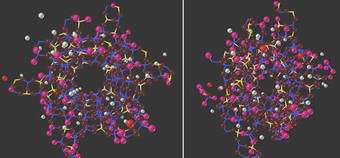On the way to the perfect glass

Researchers from the United Kingdom, France and the DUBBLE beamline at the European Synchrotron Radiation Facility (ESRF) have made a step forward in research on glass. They have monitored the change in the structure of zeolites, crystalline solids, into an almost perfect glass when heated. They have done this by recording vibrations involving groups of atoms in zeolites that subsequently characterise the glass. Their results are published today in Science.
Image: Computer simulations of zeolites (left) and what could be the perfect glass (right). Credits: Florian Meneau
Zeolites are porous crystalline aluminosilicates, presenting a regular arrangement of cages. In their natural state, they are components of soils and can be barriers against the migration of radioactive elements. In their synthetic form, zeolites are industrially applied as components of washing powders and in the cracking of petroleum to make gasoline.
Due to their cage structure, zeolites have a low-density structure. They melt at around 900°C, lower temperatures than most similar materials, such as silica (sand), which melts at twice this temperature. If the heating is carried out at a slow rate, low-frequency vibrational modes are responsible for destabilizing the microporous crystalline structure. When the cages collapse, zeolites contract, becoming 60% more denseheavier than in their original form, and they adopt the structure of a glass. “We have discovered the triggering mechanism”, says Neville Greaves, first author of the paper.
The result is a mechanically and chemically stronger glass than the glass used nowadays. “We believe this is the key to the synthesis of perfect glasses”, asserts Neville Greaves. Would this mean no more broken wine glasses? “This research could lead to that, but it is still far away. This would also mean making glass invulnerable to water, for instance”, he explains. The final aim is to find out the conditions in which the perfect glass forms.
Scientists from the University of Wales, Aberystwyth, the DUBBLE beamline at the ESRF, the Ecole Nationale Supérieure de Chimie of Paris (ENSCP) and ISIS have characterized the low-frequency vibrations that appear in zeolites during heating. The team has carried out their research in neutron as well as X-ray facilities. ISIS is a neutron and muon source located in the UK and a large part of the research presented was done there. The researchers also used a unique X-ray diffraction technique on the Dutch-Belgian beamline (DUBBLE) at the ESRF to determine the degree of crystallinity from zeolites to glass, critical to evaluate the neutron scattering results. “It is really great to combine synchrotron and neutron techniques in the same observation”, explains Greaves.
Source: European Synchrotron Radiation Facility (ESRF)















